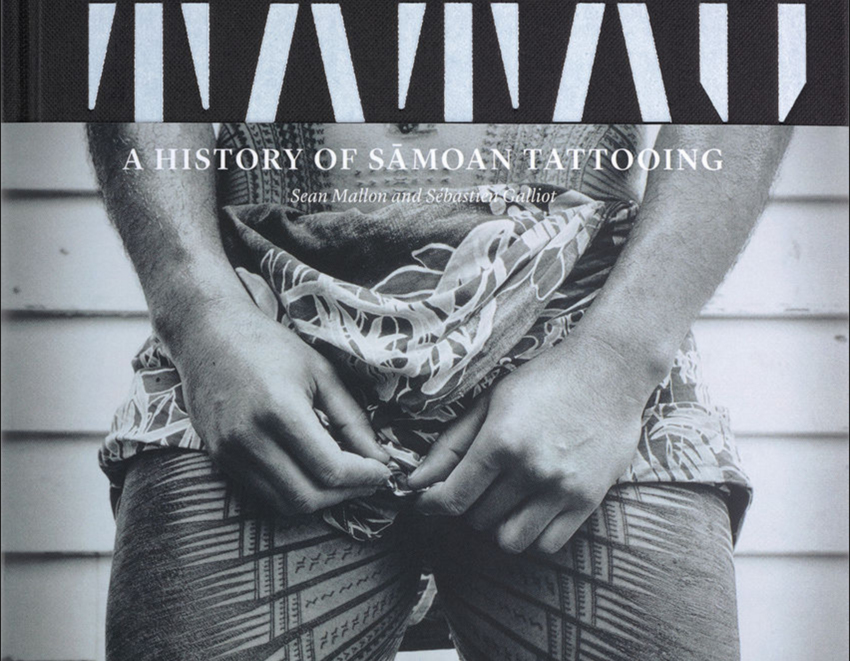TATAU: A History of Samoan Tattooing

The sacred cultural practice of Samoan ta tatau is celebrated in the much anticipated book by Sean Mallon and Sebastian Galliot.
Decades of work has gone into the comprehensive exploration of the history and shifting social contexts of the malofie in this beautiful hard cover edition. Archival information sources from around the world and historic photographs sit side by side with contemporary pop cultural references of tatau in the modern day, in this important record of the journey of tatau.

![: 17.9.2005. Avondale Road, Avondale, Auckland. From left: Lui Betham, Pasina Betham, Su‘a Tavui Pasina Iosefo Ah Ken, Fune Betham, [unidentified] and Gus Betham. Tufuga tātatau: Su‘a Tavui Pasina Iosefo Ah Ken. © Mark Adams](/assets/resized/sm/upload/uz/t3/uc/0g/Adams_fig29-0-850-0-0.jpg?k=6fcfb9d275)

For the two authors of the work, Te Papa senior curator Sean Mallon and ethnologist Sebastien Galliot the book is a labor of love of their passion and respect for this age old practice.
The book covers the 3000 year history of Samoan Tatau with a particular focus on the 1800s, the 1900s which Sebastian said they had more access to historical sources and the period in particular that they had a lot of archives and epigraphy, as well as of course the 20th & 21st centuries. "It goes from the historical – deep history, ancient history – through to the contemporary." says Sean.




The research & history was very important to them for a number of reasons. Sebastian said they'd been working on the topic for the last 15 years as well as gathering a lot of the documents, interviews and epigraphic data. "There's no-one else who has done something like this in terms of covering the history of Samoan tattooing"
Tatau is something that is also at the peak of interest and people are more interested in the subject and the art form than ever before. Sean added there's a growing diaspora and transnational communities that are really looking to connect with their history and identity. "Tatau is one of those things that is part of Samoan history and culture that a lot of people are interested in"



The Samoan tatau is very unique in the world firstly because of its history and as a lot of people know it’s the only Polynesian archipelago where it has had a continuous practise and has been continuously undertaken despite the presence of missionaries. "So that’s what we wanted to understand – how come only in Samoa? What were the historical circumstances that explain the continuity of this practise?" Sebastian said.
Sean said for him just on a pure, practise level it’s distinctive through its tools and hand tapping technique. "It’s important to me as a Samoan because it’s been a way or a medium through which to explore Samoa’s history and culture and how it’s changed over a few centuries, several centuries over 3,000 years. So tatau is a medium that allows me and hopefully other readers of the book to understand that."



The book is full of wonderful images including the double image cover (top image) which the authors said they were fortunate to be able to draw on a huge archive and bring some of the interesting, visual elements to the page. "We were very fortunate that tatau is such a distinctive set of markings that people throughout history have commented on it in writing and also created a visual record of it that goes from ethnographic hand drawn sketches through to photography, film and a whole range of media that have captured what tatau has been" Sean says.




Both Sean and Sebastian said they came across interesting & surprising stories in the research for the book. Sebastian said for him it was coming across several very interesting historical facts, for example some findings in the archives that were totally unknown in relation to the history with the way the missionaries viewed tattooing and how they tried to stop it but didn’t manage to stop it. Also, some interesting facts about the practise of Samoan tattooing being related to a religious cult back in the 19th century.
Sean said "For me one of the things that came out of the whole process of writing the book was being able to be precise about how tatau has a history of continuity and disruption. How Samoans have been the biggest instigators of change for their own art practise than any other factor. So to be able to demonstrate that and be precise has been a really wonderful outcome of the book."


In terms of how important this research is to the dialogue about Tatau in the Pacific:
Sebastian "It mainly brings another resource to people who wants to understand more about what Samoan tatau really is in terms of historical changes and historical transformation & technical transformation. We were also really interested in trying to demystify some aspects of Samoan tattooing so I hope we will manage to do that."
Sean: I think just with producing a book like Tatau and being a scholarly production – one which is accessible is to just show that a lot of our art forms that we talk about as being fixed or traditional actually have a history of change, of innovation and of creativity.



Images reproduced with permission from Tatau: A History of Sāmoan Tattooing by Sean Mallon and Sébastien Galliot, published by Te Papa Press.
